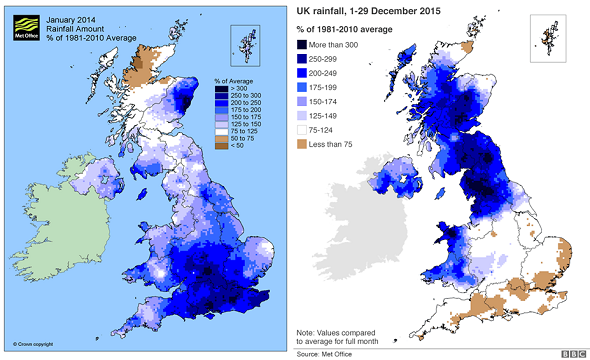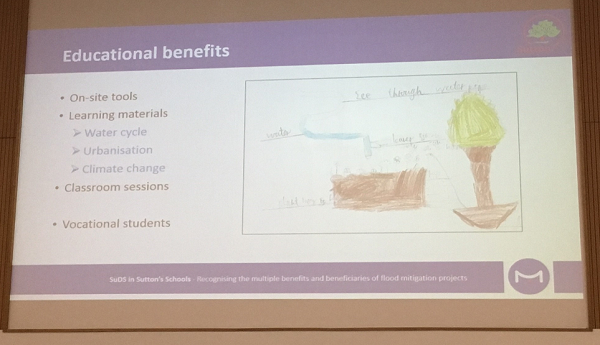
October 18, 2018, by Blue-Green team
Surface water flood risk and resilience
In this blog Emily O’Donnell reports on the key messages from the CIWEM (Chartered Institution of Water and Environmental Management) Surface Water Management 2018 conference (17th October).
The aim of the conference was to provide a review of the progress of flood risk management, resilience and response in the UK since the publication of the Pitt Review in 2008 (a response to the devastating UK floods of 2007). A range of presentations were given from local authority departments, the Environment Agency, consultants, professional organisations and governmental bodies (see conference programme).
Surface water flood risk: caused when the volume of rainfall does not drain away through the existing drainage systems or soak into the ground, instead lying on or flowing over the ground. Typically associated with heavy rainfall and storms
Sir James Bevan, Chief Executive at the Environment Agency gave an inspiring keynote on Surface water: The biggest flood risk of all, stressing the point that water does indeed get everywhere and it is imperative to identify the right measures (be it SuDS (sustainable drainage systems), Blue-Green infrastructure, or ‘traditional’ grey infrastructure, but most likely a combination) to “stop it going where it wants to” if that turns out to be people’s houses, community centres, power stations, roads or supermarkets.
Common themes
Listening to the presentations and panel discussion I noted some common themes regarding progress, lessons learned and future aspirations.
Surface water flood risk
This represents a growing risk due to projected changes in climate (wetter winters, more intense storms and rainfall events) and increased level of urbanisation (linked with a decline in permeable ‘green’ surfaces). It is a huge risk because of its reach; a severe rainfall event could potentially hit any part of the UK, as illustrated by the Met Office rainfall maps in Figure 1 that show the above average rainfall in January 2014 concentrated in the South and East, which shifted to the North and West in December 2015.

Figure 1. Illustrating the above average rainfall in the UK in Janaury 2014 and December 2015 (Source: Met Office)
Perceptions of surface water flood risk
“You may not be interested in surface water flooding, but it is interested in you. And people who don’t know they are at risk are less well prepared to cope when the risk materialises” Sir James Bevan, 17.10.18
The Environment Agency estimate that 3.2 million properties are at risk of surface water flooding in the UK (more than those at risk of fluvial, coastal or groundwater flooding) yet it is the least known source of flooding amongst communities. It is very difficult to predict the exact location, intensity and duration of this type of flooding, and the speed at which drainage systems can be overwhelmed and lead to flooding is not appreciated by most people.
SuDS, BGI, NFM
Sustainable drainage systems (SuDS), Blue-Green infrastructure (BGI), Natural Flood Management (NFM) can work alongside existing grey infrastructure to help reduce surface water flood risk while providing a range of co-benefits to the environment, society and economy. However, these measures alone will not solve surface water flood risk issues, but are valuable tools in the toolbox. The SuDS in Sutton’s Schools is a great example of co-designing SuDS to provide amenity, educational and biodiversity benefits, while delivering a flood risk management function. This project also demonstrates the effectiveness of a ‘bottom-up’ approach (Figure 2). The Blue-Green Cities research project evaluated the multiple benefits of Blue-Green infrastructure, and many organisations are working on benefit evaluation tools, such as the CIRIA B£ST Evaluation Tool.
Early engagement and public awareness
Helping people to understand, prepare for, and mitigate their surface water flood risk is key. This includes working with communities on projects to ensure that the multiple benefits are clearly communicated (and indeed desired by the communities) and ownership of schemes are with those who benefit from them. In some cases this can lead to communities taking over maintenance responsibility for SuDS (e.g. as part of gardening initiatives), which not only benefits the community by providing an amenity but also reduces the maintenance requirement of the responsible party (e.g. the local authority or water company). This also includes working with communities and homeowners to retrofit their properties to be more flood resilient, as demonstrated by the work of Warwickshire County Council in their Property Flood Resilience scheme.
Reducing overall flood risk
There was some discussion on whether we should be looking to reduce ‘flood risk’ rather than separating it into its various sources. If you are unfortunate enough to be flooded you are unlikely to be concerned over what type was responsible. In addition, flooding is often a combination of sources and developing schemes to reduce one type may also reduce another. However, from a practical perspective, it is easier to manage, and divide responsibilities, if risks are separated into these different sources.
And finally…
A pivotal thought echoed throughout the conference is that we should all remember that flooding is about people, and reducing the potential for devastating impacts on their lives. It is not just about solving equations and finding engineered solutions, but developing schemes that are effective (i.e. reduce the flood risk), but are also valued by the communities (the key beneficiaries) that they help make more flood resilient. Collaboration on designing, funding and implementing surface water flood risk management projects is key to delivering successful projects that offer good value for money, meet the objectives of numerous departments and organisations, and ultimately improve flood resilience.
Read more about Emily’s research on the Urban Flood Resilience Research Project (WP4, WP5, Newcastle LAA).
No comments yet, fill out a comment to be the first


Leave a Reply